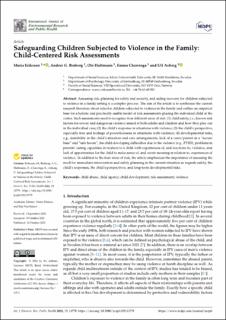| dc.contributor.author | Eriksson, Maria | |
| dc.contributor.author | Broberg, Anders G. | |
| dc.contributor.author | Hultmann, Ole | |
| dc.contributor.author | Chawinga, Emma | |
| dc.contributor.author | Axberg, Ulf | |
| dc.date.accessioned | 2022-10-28T07:34:07Z | |
| dc.date.available | 2022-10-28T07:34:07Z | |
| dc.date.created | 2022-10-24T16:06:39Z | |
| dc.date.issued | 2022 | |
| dc.identifier.citation | International Journal of Environmental Research and Public Health (IJERPH). 2022, 19 (21), 1-21 | en_US |
| dc.identifier.issn | 1661-7827 | |
| dc.identifier.uri | https://hdl.handle.net/11250/3028754 | |
| dc.description | This article belongs to the Special Issue Child Maltreatment and Well-Being | en_US |
| dc.description.abstract | Assessing risk, planning for safety and security, and aiding recovery for children subjected to violence in a family setting is a complex process. The aim of the article is to synthesize the current research literature about risks for children subjected to violence in the family and outline an empirical base for a holistic and practically usable model of risk assessments placing the individual child at the center. Such assessments need to recognize four different areas of risk: (1) child safety, i.e., known risk factors for severe and dangerous violence aimed at both adults and children and how they play out in the individual case; (2) the child’s response in situations with violence; (3) the child’s perspective, especially fear and feelings of powerlessness in situations with violence; (4) developmental risks, e.g., instability in the child’s situation and care arrangements, lack of a carer/parent as a “secure base” and “safe haven”, the child developing difficulties due to the violence (e.g., PTSD), problems in parents’ caring capacities in relation to a child with experiences of, and reactions to, violence, and lack of opportunities for the child to make sense of, and create meaning in relation to, experiences of violence. In addition to the four areas of risk, the article emphasizes the importance of assessing the need for immediate intervention and safety planning in the current situation as regards safety, the child’s responses, the child’s perspectives, and long-term developmental risks. | en_US |
| dc.language.iso | eng | en_US |
| dc.publisher | MDPI | en_US |
| dc.rights | Navngivelse 4.0 Internasjonal | * |
| dc.rights.uri | http://creativecommons.org/licenses/by/4.0/deed.no | * |
| dc.subject | violence | en_US |
| dc.subject | risk assessment | en_US |
| dc.subject | child development | en_US |
| dc.subject | child agency | en_US |
| dc.subject | child abuse | en_US |
| dc.title | Safeguarding children subjected to violence in the family: Child-centered risk assessments | en_US |
| dc.type | Peer reviewed | en_US |
| dc.type | Journal article | en_US |
| dc.description.version | publishedVersion | en_US |
| dc.rights.holder | © 2022 by the authors. Licensee MDPI, Basel, Switzerland. This article is an open access article distributed under the terms and conditions of the Creative Commons Attribution (CC BY) license (https:// creativecommons.org/licenses/by/ 4.0/) | en_US |
| dc.source.pagenumber | 1-21 | en_US |
| dc.source.volume | 19 | en_US |
| dc.source.journal | International Journal of Environmental Research and Public Health (IJERPH) | en_US |
| dc.source.issue | 21 | en_US |
| dc.identifier.doi | 10.3390/ijerph192113779 | |
| dc.identifier.cristin | 2064589 | |
| cristin.ispublished | true | |
| cristin.fulltext | original | |
| cristin.qualitycode | 1 | |

